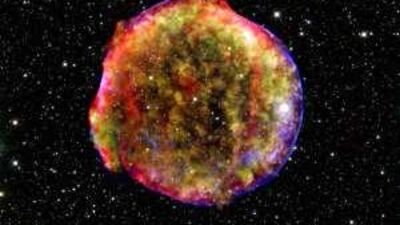As if we didn't have enough to worry about. Just as half our planet tries to cope with its worst winter for decades, along come claims that it may be about to be blasted by an exploding star. A team of astronomers last week announced the discovery of what they called a "ticking time bomb" in the southern sky, in the form of a star which is building up to explode in a supernova with the violence of 20 billion billion billion billion megatonnes of TNT. Which would not be an issue were it not for the fact that the star, named T Pyxidis, is at an astronomically piffling distance of just 3,300 light years. And that, according to some reports at least, could lead to the Earth being "wiped out".
Not surprisingly, that garnered worldwide coverage, with stories picking up on the claim of the astronomers that T Pyxidis could explode "soon". Yet as with so many of these apocalyptic stories, there is little to worry about. For a start, in astronomical circles "soon" often means not very soon at all. In the case of T Pyxidis, one of the astronomers later admitted that the conditions for a supernova explosion would not emerge for another 10 million years.
While the astronomers have undoubtedly over-egged the story in their bid to get some publicity, there is no question that T Pyxidis will go pop one day. So will it be a bang or a whimper - and could it destroy life on Earth? Some clues come from the glowing wreckage of a supernova much closer to the Earth. Found by astronomers in 1998, the so-called Vela Junior Supernova Remnant lies just 640 light-years away, barely one-fifth the distance of T Pyxidis.
Analysis of the debris revealed that the remnant is still expanding, implying that the initial explosion took place on our cosmic doorstep just 700 years ago. And the good news is, we are still here. In fact, the most worrying thing about the event is why there is no mention of it in the historical records of the 14th century. After all, accounts of much more distant and fainter supernovas appear in the archives of ancient observatories.
One theory is that the brilliant light from the explosion may have been dimmed by interstellar clouds. A more intriguing suggestion is that the outburst was seen, but contemporary astronomers simply chose to ignore it, an argument based on the discovery in 1999 of direct evidence of the impact of the Vela Junior event on our planet. As radiation from the explosion smashed into the atmosphere, it should have triggered the creation of certain chemicals that end up trapped in polar ice cores. And analysis of such cores has indeed revealed a spike in the level of the chemicals in the year 1320.
That puts the Vela Junior event at a time of great historical turmoil. The Roman Catholic Church was suffering a schism, with the Holy See moving from Rome to Avignon, while China was ruled by superstitious Mongol emperors. The astronomers of both cultures may have decided not to risk annoying their paymasters, and played down the spectacular "portent" in the night sky. There is another possibility, however: that astronomers are missing something big in their understanding of supernovas.
You would never guess that from the popular-level accounts of these titanic events. These blithely talk of two basic reasons why elderly stars blow themselves to smithereens: they are too massive, or they have an elderly companion. In the former case, the cores of massive stars start to collapse under their own gravity as they run out of nuclear fuel, and the resulting compression triggers a huge release of energy that tears them apart. In the latter case, extremely old stars known as white dwarfs go supernova when they exist in pairs, one of them pulling fresh supplies of fuel onto itself from its companion.
Yet these neat and tidy explanations hide a major embarrassment: they do not work. For decades astronomers have put together computer simulations of massive stars, and watched them as they grow old. At first all goes well: the core starts to collapse, violent nuclear reactions are triggered and then - well, nothing. Time and again, simulations of massive stars just show them continuing to collapse under their own weight until they fizzle out.
The picture is no less perplexing with white dwarfs. It was once thought they produced a supernova because one of the pair grabbed so much fuel from its companion that it collapsed under its own weight, and detonated according to the usual theory. The trouble is that unless the white dwarf gets hold of a whole lot of fuel, it just sputters and fizzes in a series of far less dramatic "nova" explosions. On the other hand, the light from supernovas shows no sign of huge amounts of fuel being suddenly added.
In the current issue of the journal Nature, a team of theorists from the Max Planck Institute for Astrophysics in Germany suggests a dramatic solution: perhaps the two white dwarfs just crash into each other. Computer simulations suggest that the result is a supernova - albeit a pretty faint one. This might explain the paradox of the 14th-century supernova, which left its mark in the snows of Antarctica yet failed to appear in the astronomical records of the time. But it does little to explain the textbook supernova, whose proverbial brilliance can briefly outshine the entire galaxy.
Like the suggestion that our planet faces imminent destruction, reports that astronomers understand the death of stars have been greatly exaggerated. Robert Matthews is Visiting Reader in Science at Aston University, Birmingham, England

